1. INTRODUCTION
My deep interest in the light scattering in Earth’s atmosphere arose out of my observations of the behavior of the Earth’s atmosphere, especially around sunrise, sunset (golden hour, blue hour, twilight), and during eclipses. I like to observe the weather phenomena and atmosphere response to environmental phenomena both live and remotely.
Due to this, I would like to describe the general light scattering phenomenon in this series of pretty long articles, knowing that the interaction of light with matter is one of the most fundamental processes that occur in nature.
Most of the light we see reaches our eyes in an indirect way. Looking at a tree or a house, we see diffusely reflected sunlight. Looking at a cloud, or at the sky, we see scattered sunlight. Even an electric lamp does not send us light directly from the luminous filament but usually shows only the light that has been scattered by a bulb of ground glass (Hulst, 1981). The light, seen by us in an indirect way is definitely sunlight and moonlight. Sometimes, especially in areas free of light pollution, we can experience weak light coming from the brightest celestial objects like Venus or starlight in general. This is then a subject for consideration in future articles.
Earth’s atmosphere consists of a lot of substances commonly known as air, which scatter and absorb the light, that both come from space and terrestrial sources of illumination. Moreover the way of scattering and absorption changes in terms of the astronomical and weather conditions. If you are reading this text you are in the right place, which brings you general knowledge about these issues.
2. THE INTERACTION OF LIGHT WITH SMALL PARTICLES, QUANTUM THEORY
The wavelength of visible light is quite small. A typical human eye will respond to wavelengths from about 390 (deep violet color) to 700nm (deep red color) (Starr et al., 2006). This is a small range within the solar radiation spectrum with the highest spectral irradiance (Pic. 1).

Any simple wave of light takes part in complicated environmental events, that are all-optical phenomena. Once light enters the atmosphere can be scattered, reflected, refracted, and diffused.
Let’s take a look at the interaction of light with small particles. For a better understanding of this process, I have brought the quantum theory of light. The quantum theory of light has been created by Einstein in 1905. The theory says, that the light propagating through a vacuum can be thought of as a stream of particles, called photons, that have wavelike properties. The matter is composed of atoms, the smallest constituent. When photons touch the matter we have a photoelectric effect. The photoelectric effect is the emission of electrons (photoelectrons) when light shines on a material. When light encounters a surface or passes through a medium, inevitable interaction occurs between the light and the electrons of the atoms and molecules of the material (Flammer, 2013).
Light is an electromagnetic wave, however, according to the corpuscular theory of light, it has a dual nature. Both can also expand and radiate in all directions, carry energy and momentum, and interfere with other waves.
The interaction of electromagnetic radiation with atoms and molecules is called spectroscopy. There are various types of spectroscopy depending on the frequency of light we are using.
The atoms and molecules absorb the photons, thereby absorbing their energy. Depending on the energy of the photon absorbed or emitted, different phenomena can occur. When the atom absorbs a photon of visible light, the energy of that photon can excite one of that atom’s electrons to a higher energy level (transition process). In order to occur this, the energy of the photon absorbed must be greater than (or at least equal) to the difference of energy between the 2 energy levels. See the movie below to get what’s going on.
The transition process can be shown on the graph in order to easier understanding of the colors of our surroundings. The picture below (Pic. 2) shows the different energy level transitions possible for the hydrogen atom. When a larger transition occurs between energy levels, more energy is absorbed or emitted.
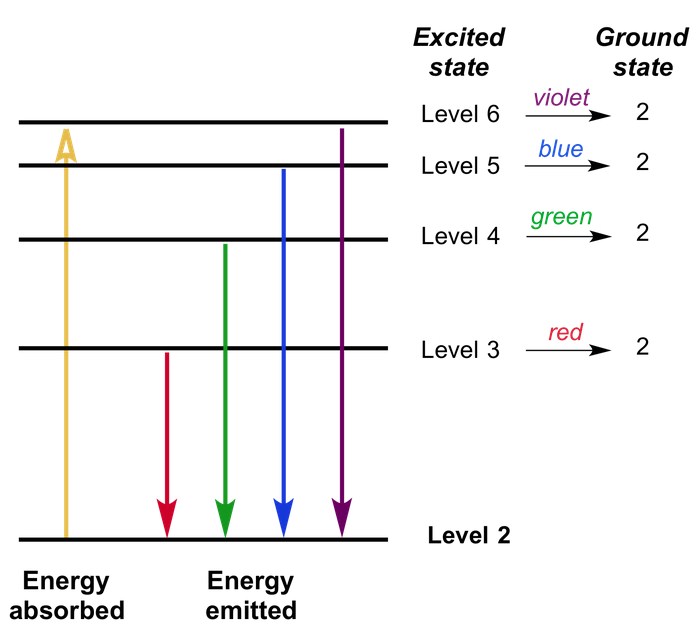
The energy transitions for the electrons of each element are unique and distinct from one another. Therefore we can examine the colors of light emitted by a particular atom and identify that element based on its emission spectrum (Pic. 3).

3. KINDS OF SCATTERING
There are basically two kinds of light scattering. Single and multiple scattering.
– Single scattering occurs when radiation is only scattered by one localized scattering center. It simply takes place, when light is scattered by one particle. This kind of scattering can be treated as a random phenomenon and may refer to up to 10% of total light scattering. For instance when light is scattered from one water droplet (or multiple droplets set apart), then we can say about single scattering.
– Multiple scattering is very common in Earth’s atmosphere due to the enormous amount of molecules and particles. The light beam is scattered by a great number of particles at once. Back to the droplet of water case, the multiple scattering will take place, when light is scattered from one droplet and then scattered from another and repeatedly from yet other droplets. Another example of multiple scattering can be found during twilight conditions or when observing the phenomena outside the Earth’s atmosphere like zodiacal light as an effect of the scattering of sunlight by interplanetary dust spread throughout the Solar System (Pic. 4).

4. SCATTERING VS. ABSORPTION, EXTINCTION, AND TRANSMISSION
It is important to understand the difference between scattering, absorption, extinction, and transmission. The interaction of light with matter entails the interaction of a single atom with a single quantum of light (photon). In a moment, when an atom interacts with a photon three things may happen. This is absorption, scattering, extinction, and also transmission.
Scattering – is a process, where light photons are forced to deviate from a straight trajectory by one or more paths due to localized non-uniformities in the medium through which they pass. Imagine then one beam of light, which is subsequently divided to go towards multiple directions (Pic. 5).
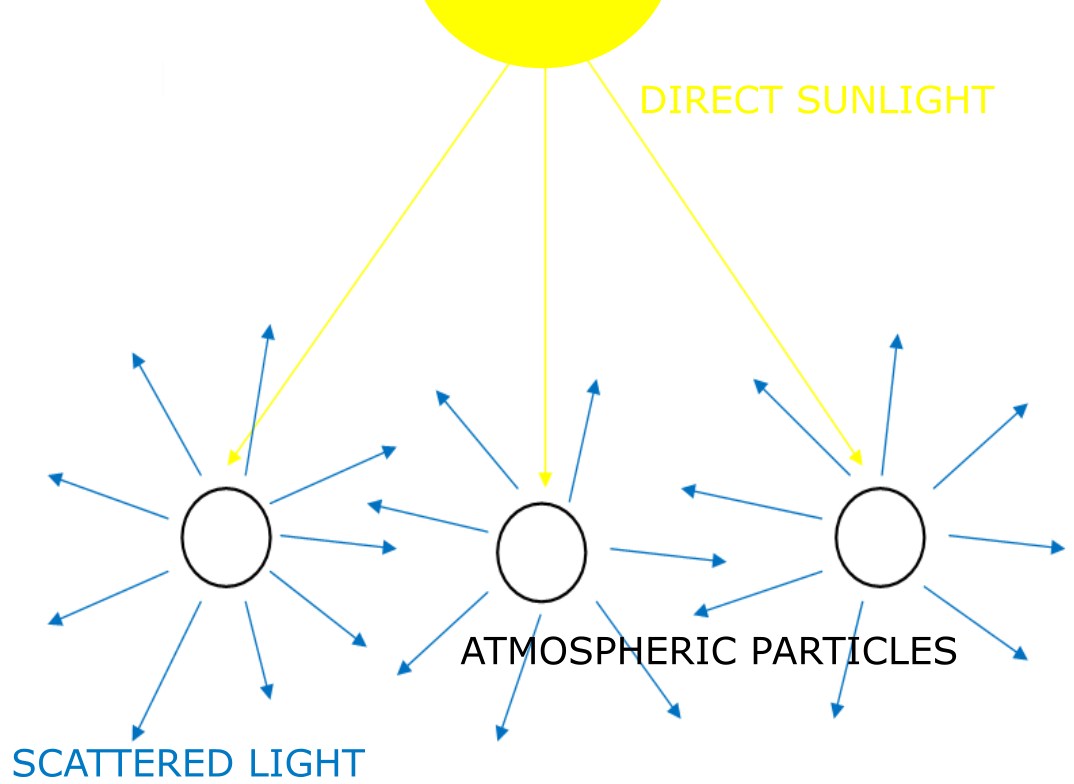
Absorption – is the way in which the energy of a photon of light is taken up by matter (Pic. 6) and then transformed into energy. The absorption of light waves depends on the electromagnetic frequency of the light and the object’s natural atom. Absorption depends on the state of an object’s electron (Hulst, 1981). All electrons vibrate at a specific, natural frequency. Hence we have different colors of objects because each object has its own natural frequency of light (Pic. 2). Some parts of the light are absorbed by the object, which the outcome gives thermal energy and some are reflected in certain wavelengths (Pic. 7).

Some objects absorb all light wavelengths like dark objects, hence these objects are the warmest when exposed to the source of light. Light absorption is often accompanied by scattering. We can also say, that leaves look green because it scatters green light more effectively than red light.

Extinction (or attenuation) – is a gradual loss of light intensity through a medium (Pic. 8). The extinction is a sum of scattering and absorption because both scattering and absorption remove energy from a beam of light traversing the medium (Hulst, 1981). The best example is the Sun, which is much fainter during the sunrise or sunset than at noon.
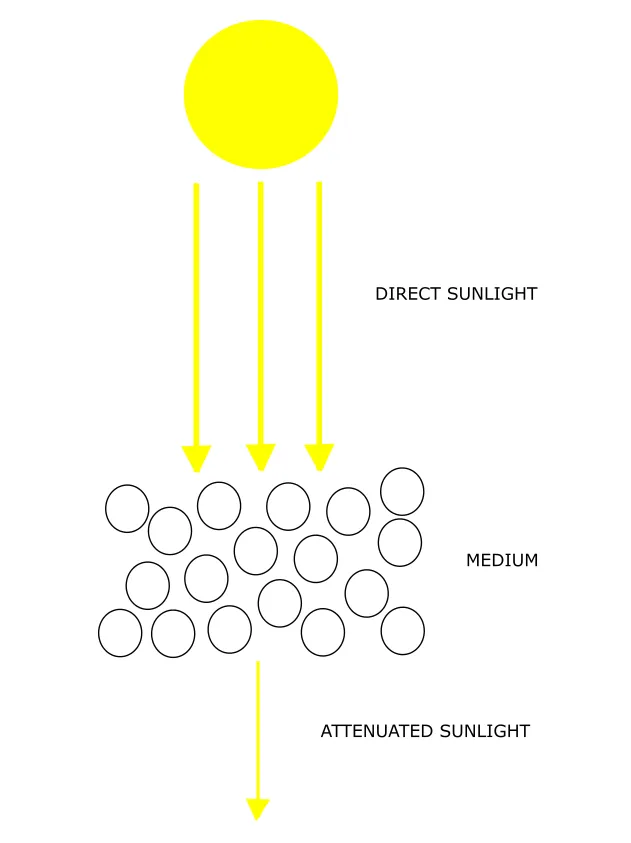
Transmission – is the way of light through a transparent or semi-transparent medium without being absorbed (Pic. 7). The transmission informs us about the proportion of the incident light, that moves all the way through the material (medium). The best example of light transmission is Earth’s atmosphere, where the light coming from space (vacuum) proceeds through the gaseous medium all the way down to the surface (observer).
5. TYPES OF LIGHT SCATTERING
Rayleigh scattering – this is the most common light scattering present in Earth’s atmosphere, that relates to the smallest particles, usually much smaller than the light wavelength. Wait for the next article to learn more about this kind of scattering.
Mie scattering – another common type of light scattering in the Earth’s atmosphere, that occurs when particles are more or less equal to light wavelength. In this case, we speak about atmospheric aerosols. This is also a topic to develop in further writing.
Non-selective scattering – is often confused with Mie scattering, because refers to the bigger particles. Non-selective scattering occurs when the particles are much larger than the wavelength of the radiation. This type of scattering can cause water droplets and large dust particles. Unfortunately, you will not know more from this article, because it will be described separately.
Brillouin scattering – scattering refers to the interaction of light and material waves within a medium. This kind of scattering involves the inelastic scattering of light caused by the vibrational properties of matter. The Brillouin scattering occurs on sound waves, which propagates in solid. This kind of scattering enables us to set the sound velocity.
Raman scattering – is the inelastic scattering of a photon by molecules, which are excited to higher vibrational or rotational energy levels. When photons are scattered from an atom or molecule most of them are elastically scattered, so they have the same energy (frequency and wavelength) as the incident photons. A small fraction is scattered inelastically having different energy and frequency and usually lower than those of incident photons (Harris, Bertolucci, 1989). The Raman scattering can be used in setting the temperature of the scattering object.
The first 3 types (Rayleigh, Mie, and non-selective)) belong to elastic scattering, in which the energy of radiation is not changed due to scattering. Another 2 types (Brillouin and Raman scattering) represent inelastic scattering, where the energy of the scattered radiation is changed. In inelastic energy, some or all kinetic energy of light is absorbed due to collision with solids or particles.
6. PHENOMENA RELATED TO LIGHT SCATTERING – SIMILARITIES AND DIFFERENCES
6.1. Reflection
The direction of light changes when the wavelength touches the surface. It depends on the surface. Important is the law of reflection, which says that the angle at which the wave is incident on the surface equals the angle at which it is reflected (Pic. 9).

We have 3 types of reflection (Pic. 11):
– specular reflection (so-called mirror-like reflection), which clearly corresponds with the law of reflection (Pic. 9). In this case, light scattered is in the opposite direction of the incident light. This can be seen on surfaces such as mirrors or a calm body of water (Pic. 10).

– lustrous reflection, which is something else between specular and diffuse reflection. It occurs, when the surface is almost ideal, however, some smallish roughness exists. A part of the light can be reflected specularly, and another part may be reflected diffusely or scattered (Denham, Lonsdale, 1924). A good example of it is paper or some lustrous metals like platinum, gold, or iridium (Pic. 25).
– diffuse reflection, which is much more common because it takes place when the surface is not ideal. Roughness causes multiple reflections and scattering in different directions (Pic. 11, 12).
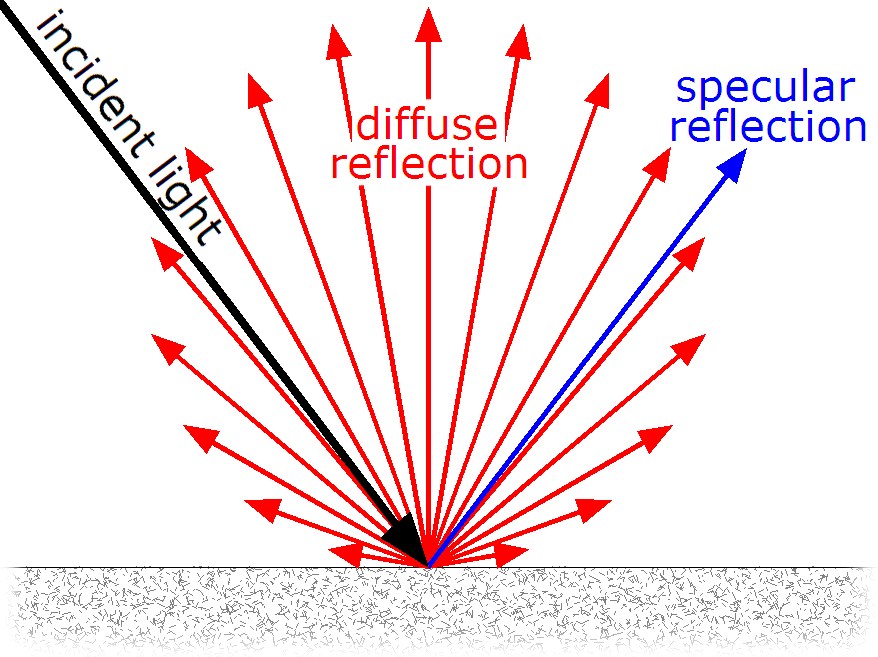
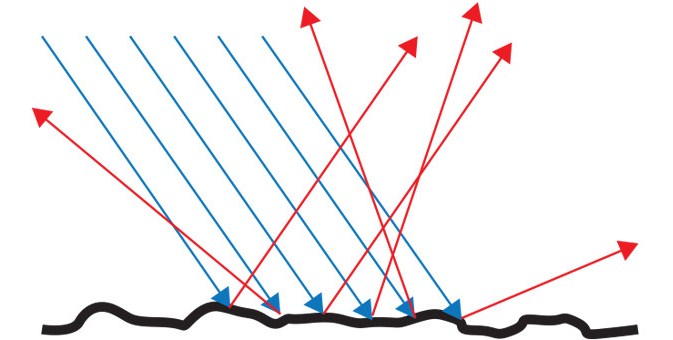
The exact form of the diffuse reflection depends on the structure of the material. Both scattering and reflection occur and overlap, however, there is a simple difference between each other (Pic. 13). The main factor controlling them is particle size. When particles are smaller than light wavelengths then we have scattered. Once the particle size is bigger than the light wavelength then we have a reflection Phenomenon.
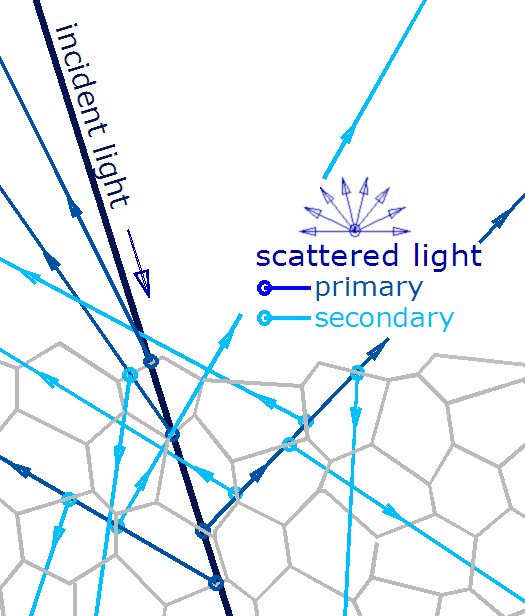
The light reflected from some object, which in the atmosphere can be a cloud (built by small water droplets, but bigger than light wavelength size) will fall within the absorptivity (Beer-Lambert law). It arises out of the attenuation of light traveling through the atmosphere. We can see it in the cloud cover perspective when further clouds look fainter (during hazy conditions) (Pic. 14 – 16). Reflection is much easier observable.



6.2. Refraction
Refraction is the change of direction of wave propagation due to a change in its transmission medium (Pic. 17).

The transmitted light appears to travel slower through the dense medium. For example, waves in the air will travel faster than in the water. When the ray of light enters from the air to the water is bent. The velocity of the light wave changes unlike the frequency, which remains constant. Refraction is less related to scattering than other phenomena because its mechanism is quite different. Refraction occurs when a large number of dipoles scatter coherently. Each individual particle scatters light in response to the incident radiation in almost all directions. We have to know, that there is a large collection of these scattered, whereas each one scattering the light in each direction. The contribution of each scatterer interferes with every other contribution against the total field. Reassuming the main difference between light scattering and light refraction is that scattering refers to small scatterers and refraction requires a large number of scatterers and a clean interface too. There are many more details, as we can get to know about light refraction. I am planning to develop this topic in the future.
6.3 Diffraction
Diffraction is the slight bending of light as it passes around the edge of an object. The amount of bending depends on the relative size of the wavelength of light to the size of the opening. When an opening is much larger than the light’s wavelength, the bending will be almost unnoticeable. In the atmosphere, diffracted light is actually bent around atmospheric particles – mainly tiny water droplets found in the clouds (Pic. 18).

Diffracted light can produce fringes of light and dark or colored bands. An optical effect that results from the diffraction of light is the silver lining sometimes found around the edges of clouds or coronas surrounding the Sun or Moon (Pic. 19).

The basic difference between diffraction and scattering is that diffraction is a phenomenon observed only in waves unlike scattering, which can be observed in both waves and particles.
Diffraction we can understand as a property of propagation of waves, whereas scattering is a property of wave interactions. Both are caused by the interaction of waves with objects
6.4 Interference
Light interference is an output of the diffraction. In the common case, when sunlight or moonlight encounters a cloud droplet, light waves are altered and interact with one another. It works likewise in water waves, where the incident waves touch the flow. At the outcome, the flow starts producing waves on its own, that spread in all directions and interact with other waves. If the crest of two waves combines, an amplified wave is produced (constructive interference). In the opposite case, when the crest of one wave and the trough of another wave combine, they cancel each other to produce no vertical displacement (destructive interference). Back to light waves, constructive interference will cause the light to appear brighter. When destructive interference the light either appears darker or disappears entirely (Pic. 20).
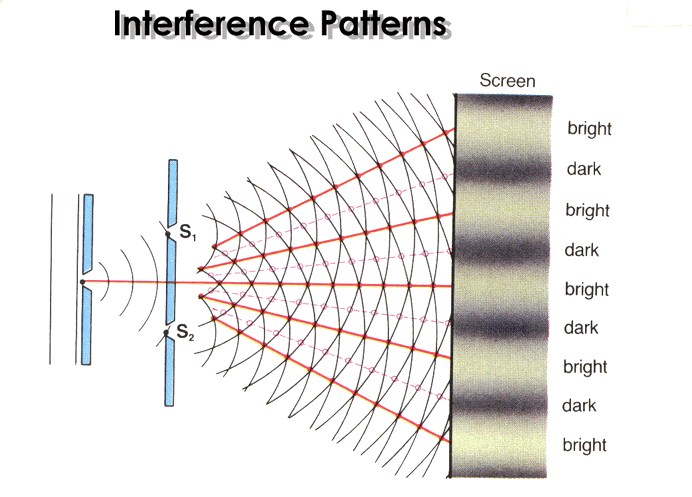
Light interference can produce phenomena with a combination of diffraction, reflection, and scattering (or backscattering) like solar glory (Pic. 21).
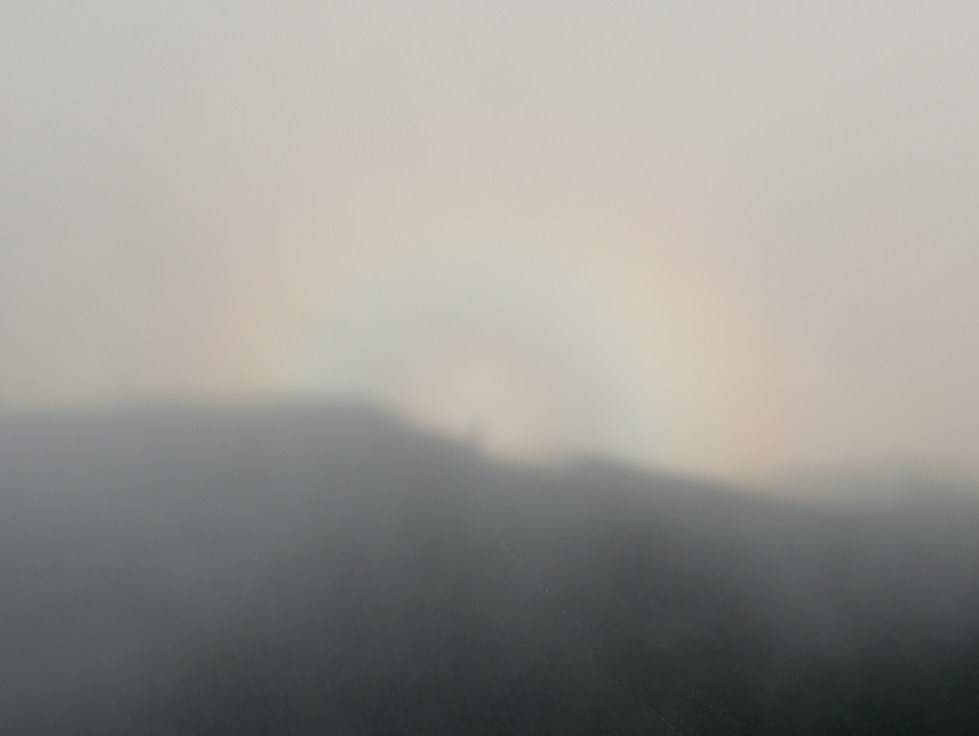
Interference, similarily to diffraction can be observed only on waves unlike scattering, which can be observed on waves and particles.
6.5 Dispersion
Dispersion is a special case of scattering, where all wavelengths are scattered proportionately and evenly. Dispersion is the phenomenon, in which the phase velocity of a wave depends on its frequency (Born, Wolf, 1999). The best example of light dispersion in Earth’s atmosphere is a rainbow phenomenon (Pic. 23), that is caused by raindrops. These raindrops play the role of the dispersive prism, where the light is scattered evenly from white light to several colors of the spectrum, which we can call simply VIBGYOR. VIBGYOR means Violet, Indigo, Blue, Green, Yellow, Orange, and Red (Pic. 22).
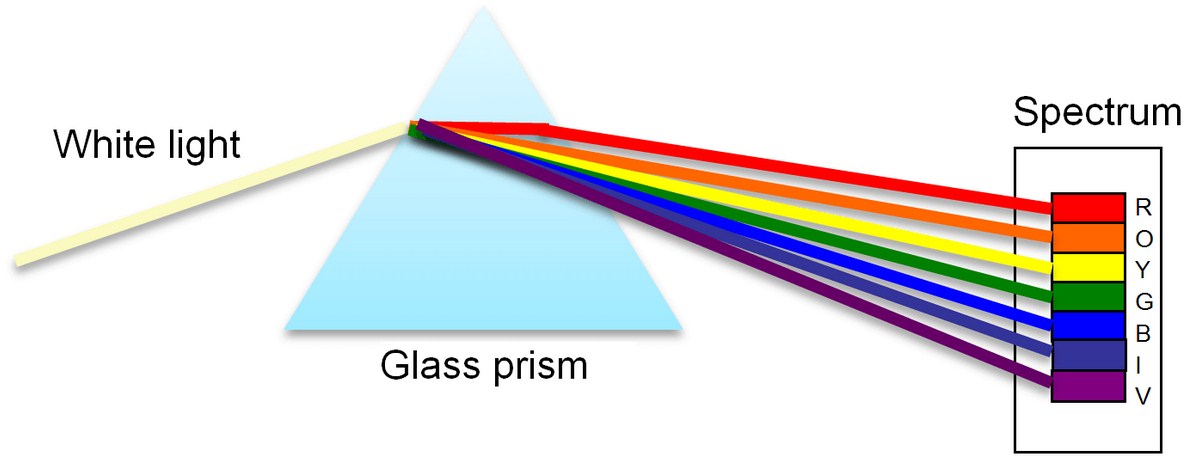
Dispersion means, that the higher-frequency light bends more in the prism.
7. OPTICAL EFFECTS RELATED TO LIGHT SCATTERING
This is also the issue, that I will describe in forthcoming articles. Basically, I would like to show you the optical effects related to scattering, caused by haze, clouds, and surface.
Watching the surface we can spot some optical effects. One of them is the mirror effect when light is reflected from a plain surface like a lake (Pic. 10). Another noticeable one is the opposite effect (also called shadow hiding). When looking in a direction away from the Sun, shadows are hidden by the objects casting them (Pic. 24).

The antisolar point appears to be brighter. Finally, this area appears to have a larger number of scattering centers. The light scatters preferentially back the way it came reaching a local maximum in the backward direction. This is the retroreflection phenomenon called coherent backscatter. It occurs on rock minerals.
Another example refers to the general interaction of light with the surface (Pic. 25), where the color of the initial ray of light is to be modified by the color of the local surface through the absorption properties of this surface. In the outcome, the scattered light has a different color than the initial one.

The picture above shows the summary of the reflection of the light issue and the optical phenomena related to it.
8. SUMMARY
The light scattering in the Earth’s atmosphere is a very wide topic strongly associated with another light phenomenon as well as atmospheric optics. Due to this is really hard to distinguish solely light scattering itself not to mention reflection or refraction. Hence these processes are often confused. The scattered light is a part of huge atmospheric optical phenomena, that contribute to the general response of all substances, molecules, and aerosols included. Treat this article as an introduction to a huge presentation of atmospheric properties, that impact light distribution and visibility properties in your area. Having this knowledge you will be able to point out the best moment to conduct the observation of the night sky, observe the atmospheric phenomena, or take a photo of a remote object from your area.
Mariusz Krukar
References:
- Born M., Wolf E., 1999, Principles of Optics, Cambridge University Press, Cambridge
- Denham W.S., Lonsdale T., 1924, The reflection of light from lustrous materials, (in:) Journal of the Textile Institute Transactions, vol. 15, issue 10
- Flammer J., Mozzafarieh M., Bebie H., 2013, The interaction between light and matter (in:) Basic sciences in Ophthalmology; Physics and Chemistry, Oxford University Press, Oxford
- Harris D. C., Bertolucci M. D., 1989, Symmetry and Spectroscopy, Dover publications, New York
- Hulst H. C., 1981, Light scattering by small particles, Dover Publications Inc, New York
- Starr C., E., Evers C., A., 2006, Biology: Concepts and Applications, Cengage Learning, Boston
Links:
- Quantum theory of light
- 5 facts about light
- UV Visible absorption spectra
- Light-Absorption,-Reflection,-and-Transmission
- The-Law-of-Reflection
- Brillouin_scattering – explanation
- Specular vs diffuse reflection
- Refraction and sight
- The reflection of light
- Diffraction of light
- Diffraction of light – explanation
- Light scattering in Earth’s atmosphere by clouds and haze – basic concepts
- Shadow hiding
- Coherent backscatter
Wiki:
- Sunlight
- Visible_spectrum
- Corpuscular_theory_of_lightCorpuscular_theory_of_light
- Photoelectric_effect
- Scattering
- Light scattering by particles
- Reflection
- Diffuse_reflection
- Beer – Lambert_law
- Wave_interference
- Dispersive_prism
- Phase_velocity
- Coherent_backscattering

